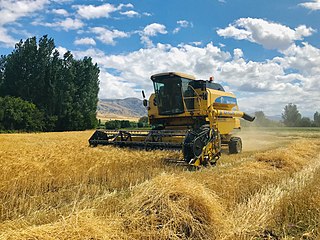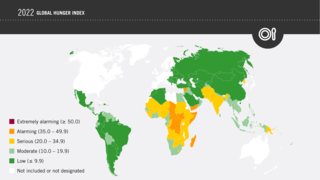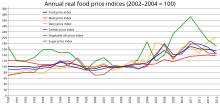
In politics, humanitarian aid, and the social sciences, hunger is defined as a condition in which a person does not have the physical or financial capability to eat sufficient food to meet basic nutritional needs for a sustained period. In the field of hunger relief, the term hunger is used in a sense that goes beyond the common desire for food that all humans experience, also known as an appetite. The most extreme form of hunger, when malnutrition is widespread, and when people have started dying of starvation through lack of access to sufficient, nutritious food, leads to a declaration of famine.

Food security is the availability of food in a country and the ability of individuals within that country (region) to access, afford, and source adequate foodstuff. The availability of food irrespective of class, gender or region is another element of food security. Similarly, household food security is considered to exist when all the members of a family, at all times, have access to enough food for an active, healthy life. Individuals who are food secure do not live in hunger or fear of starvation. Food insecurity, on the other hand, is defined as a situation of " limited or uncertain availability of nutritionally adequate and safe foods or limited or uncertain ability to acquire acceptable foods in socially acceptable ways". Food security incorporates a measure of resilience to future disruption or unavailability of critical food supply due to various risk factors including droughts, shipping disruptions, fuel shortages, economic instability, and wars.

Food distribution is the process where a general population is supplied with food. The Food and Agriculture Organization (FAO) considers food distribution as a subset of the food system. The process and methodology behind food distribution varies by location. Food distribution has been a defining characteristic of human behavior in all societies, and recordings of food distribution date back for thousands of years. Most governments and societies are highly shaped by the systems created to support food distribution.

Malawi is one of the world's undeveloped countries and is ranked 170 out of 187 countries according to the 2010 Human Development Index. It has about 16 million people, 53% of whom live under the national poverty line, and 90% of whom live on less than $2 per day.
Food politics is a term which encompasses not only food policy and legislation, but all aspects of the production, control, regulation, inspection, distribution and consumption of commercially grown, and even sometimes home grown, food. The commercial aspects of food production are affected by ethical, cultural, and health concerns, as well as environmental concerns about farming and agricultural practices and retailing methods. The term also encompasses biofuels, GMO crops and pesticide use, the international food market, food aid, food security and food sovereignty, obesity, labor practices and immigrant workers, issues of water usage, animal cruelty, and climate change.
Export restrictions, or a restriction on exportation, are limitations on the quantity of goods exported to a specific country or countries by a Government. Export restrictions could be aimed at achieving diverse policy objectives such as environmental protection, economic welfare, social wellbeing, conversion of natural resources, and controlling inflationary pressures. There are various forms of restrictions on export as defined by WTO's Trade Policy Reviews (TPR), for example, export duties, quantitative restrictions, voluntary export restrictions, export prohibitions and licensing requirements. Although some countries apply export restriction of various policy purposes, restrictions on exports provide price advantage for the domestic industries because these restrictions create price difference between domestic goods compared to the price of the same goods to foreign investors. Export restrictions don't always provide benefits for the country and more income for the government. In the field of agriculture and food sector export restrictions are aimed at protecting the domestic food security from international supply. During the food crises of 2007–2008, more than thirty countries imposed various export restriction measures such as quantitative export restrictions, prohibitions, export taxes, and price controls to protect the domestic food supply. However, this created additional pressures on the food crises by imposing high global prices and affecting the supply of food in the international market.

A sustainable food system is a type of food system that provides healthy food to people and creates sustainable environmental, economic, and social systems that surround food. Sustainable food systems start with the development of sustainable agricultural practices, development of more sustainable food distribution systems, creation of sustainable diets, and reduction of food waste throughout the system. Sustainable food systems have been argued to be central to many or all 17 Sustainable Development Goals.

Agriculture is still an important sector of Turkey's economy, and the country is one of the world's top ten agricultural producers. Wheat, sugar beet, milk, poultry, cotton, vegetables and fruit are major products; and Turkey is the world's largest grower of hazelnuts, apricots, and oregano.

Agriculture in Ghana consists of a variety of agricultural products and is an established economic sector, providing employment on a formal and informal basis. It is represented by the Ministry of Food and Agriculture. Ghana produces a variety of crops in various climatic zones which range from dry savanna to wet forest which run in east–west bands across Ghana. Agricultural crops, including yams, grains, cocoa, oil palms, kola nuts, and timber, form the base of agriculture in Ghana's economy. In 2013 agriculture employed 53.6% of the total labor force in Ghana.

World food prices increased dramatically in 2007 and the first and second quarter of 2008, creating a global crisis and causing political and economic instability and social unrest in both poor and developed nations. Although the media spotlight focused on the riots that ensued in the face of high prices, the ongoing crisis of food insecurity had been years in the making. Systemic causes for the worldwide increases in food prices continue to be the subject of debate. After peaking in the second quarter of 2008, prices fell dramatically during the late-2000s recession but increased during late 2009 and 2010, reaching new heights in 2011 and 2012 at a level slightly higher than the level reached in 2008. Over the next years, prices fell, reaching a low in March 2016 with the deflated Food and Agriculture Organization (FAO) food price index close to pre-crisis level of 2006.
The term food system describes the interconnected systems and processes that influence nutrition, food, health, community development, and agriculture. A food system includes all processes and infrastructure involved in feeding a population: growing, harvesting, processing, packaging, transporting, marketing, consumption, distribution, and disposal of food and food-related items. It also includes the inputs needed and outputs generated at each of these steps. Food systems fall within agri-food systems, which encompass the entire range of actors and their interlinked value-adding activities in the primary production of food and non-food agricultural products, as well as in food storage, aggregation, post-harvest handling, transportation, processing, distribution, marketing, disposal, and consumption. A food system operates within and is influenced by social, political, economic, technological and environmental contexts. It also requires human resources that provide labor, research and education. Food systems are either conventional or alternative according to their model of food lifespan from origin to plate. Food systems are dependent on a multitude of ecosystem services. For example, natural pest regulations, microorganisms providing nitrogen-fixation, and pollinators.

The Global Hunger Index (GHI) is a tool that attempts to measure and track hunger globally as well as by region and by country, prepared by European NGOs of Concern Worldwide and Welthungerhilfe. The GHI is calculated annually, and its results appear in a report issued in October each year.
In the agricultural context, diversification can be regarded as the re-allocation of some of a farm's productive resources, such as land, capital, farm equipment and labour to other products and, particularly in richer countries, to non-farming activities such as restaurants and shops. Factors leading to decisions to diversify are many, but include: reducing risk, responding to changing consumer demands or changing government policy, responding to external shocks and, more recently, as a consequence of climate change.

Human food is that food which is fit for human consumption, and which humans willingly eat. Not all things that are edible constitute human food. Food is a basic necessity of life, and humans typically seek food out as an instinctual response to hunger.

Gender inequality both leads to and is a result of food insecurity. According to estimates, women and girls make up 60% of the world's chronically hungry and little progress has been made in ensuring the equal right to food for women enshrined in the Convention on the Elimination of All Forms of Discrimination Against Women. Women face discrimination both in education and employment opportunities and within the household, where their bargaining power is lower. On the other hand, gender equality is described as instrumental to ending malnutrition and hunger. Women tend to be responsible for food preparation and childcare within the family and are more likely to be spent their income on food and their children's needs. The gendered aspects of food security are visible along the four pillars of food security: availability, access, utilization and stability, as defined by the Food and Agriculture Organization.

Sustainable Development Goal 2 aims to achieve "zero hunger". It is one of the 17 Sustainable Development Goals established by the United Nations in 2015. The official wording is: "End hunger, achieve food security and improved nutrition and promote sustainable agriculture". SDG 2 highlights the "complex inter-linkages between food security, nutrition, rural transformation and sustainable agriculture". According to the United Nations, there are around 690 million people who are hungry, which accounts for slightly less than 10 percent of the world population. One in every nine people goes to bed hungry each night, including 20 million people currently at risk of famine in South Sudan, Somalia, Yemen and Nigeria.
The 2021–2023 global energy crisis began in the aftermath of the COVID-19 pandemic in 2021, with much of the globe facing shortages and increased prices in oil, gas and electricity markets. The crisis was caused by a variety of economic factors, including the rapid post-pandemic economic rebound that outpaced energy supply, and escalated into a widespread global energy crisis following the Russian invasion of Ukraine. The price of natural gas reached record highs, and as a result, so did electricity in some markets. Oil prices hit their highest level since 2008.

Agrifood systems encompass the primary production of food and non-food agricultural products, as well as in food storage, aggregation, post-harvest handling, transportation, processing, distribution, marketing, disposal and consumption. Within agrifood systems, food systems comprise all food products that originate from crop and livestock production, forestry, fisheries and aquaculture, and from other sources such as synthetic biology, and that are intended for human consumption.
During 2022 and 2023 there were food crises in several regions as indicated by rising food prices. In 2022, the world experienced significant food price inflation along with major food shortages in several regions. Sub-Saharan Africa, Iran, Sri Lanka, Sudan and Iraq were most affected. Prices of wheat, maize, oil seeds, bread, pasta, flour, cooking oil, sugar, egg, chickpea and meat increased. The causes were disruption in supply chains from the COVID–19 pandemic, an energy crisis, the Russian invasion of Ukraine and some effects of climate change on agriculture. Significant floods and heatwaves in 2021 destroyed key crops in the Americas and Europe. Spain and Portugal experienced droughts in early 2022 losing 60-80% of the crops in some areas.
The 2020s commodities boom refers to the rise of many commodity prices in the early 2020s following the COVID-19 pandemic. The COVID-19 recession initially made commodity prices drop, but lockdowns, supply chain bottlenecks, and dovish monetary policy limited supply and created excess demand causing a commodity super cycle rise.
















